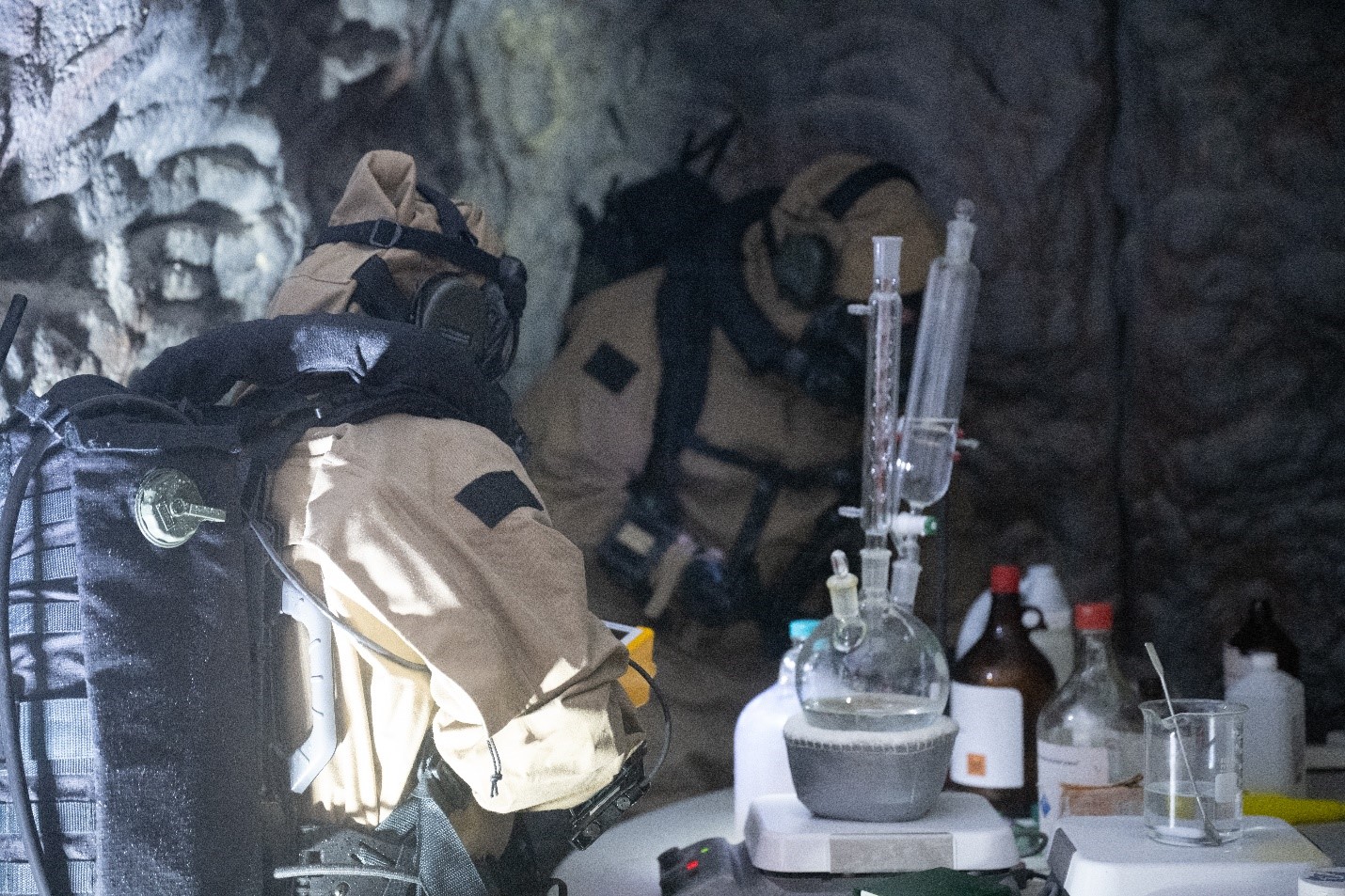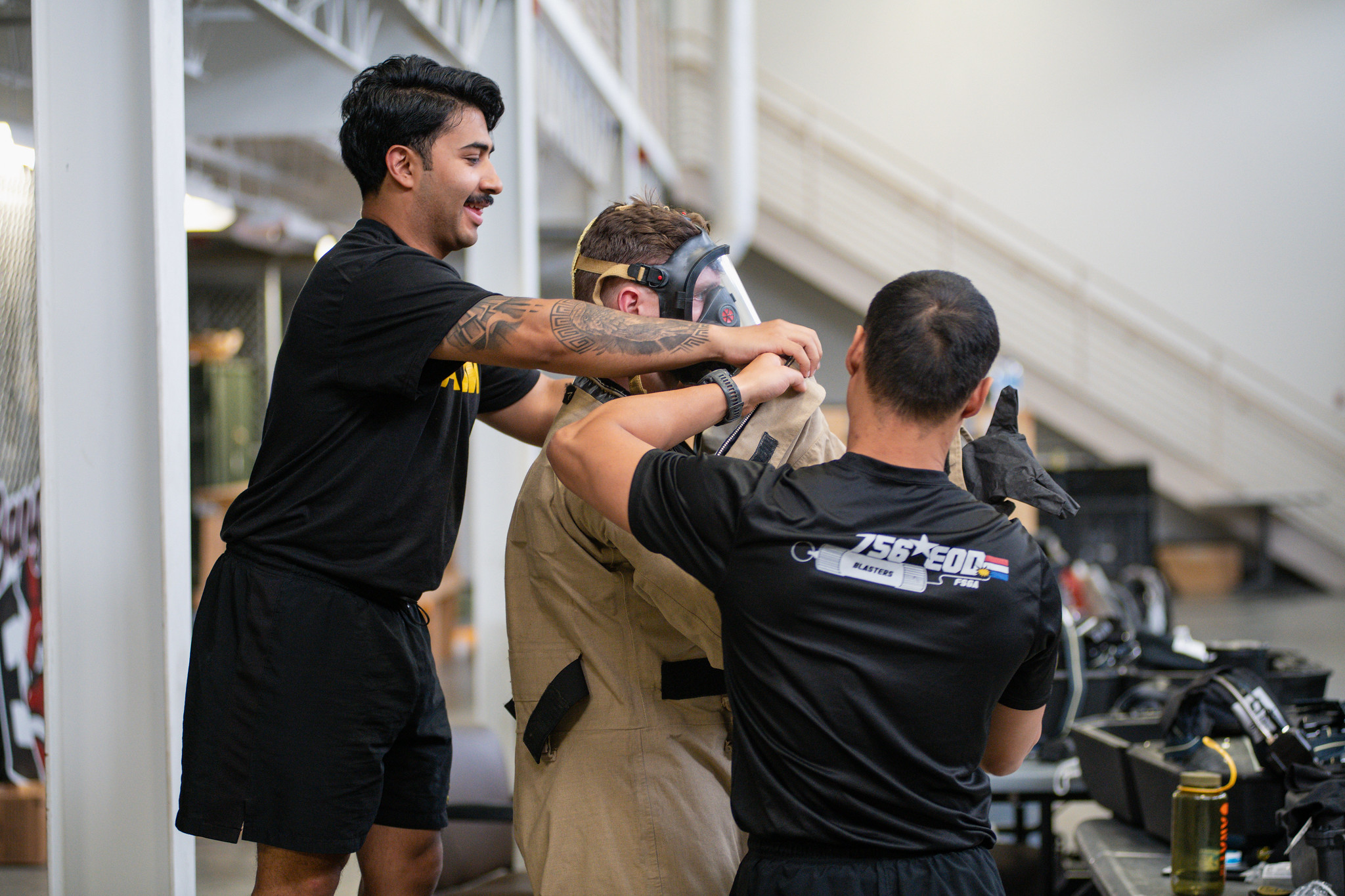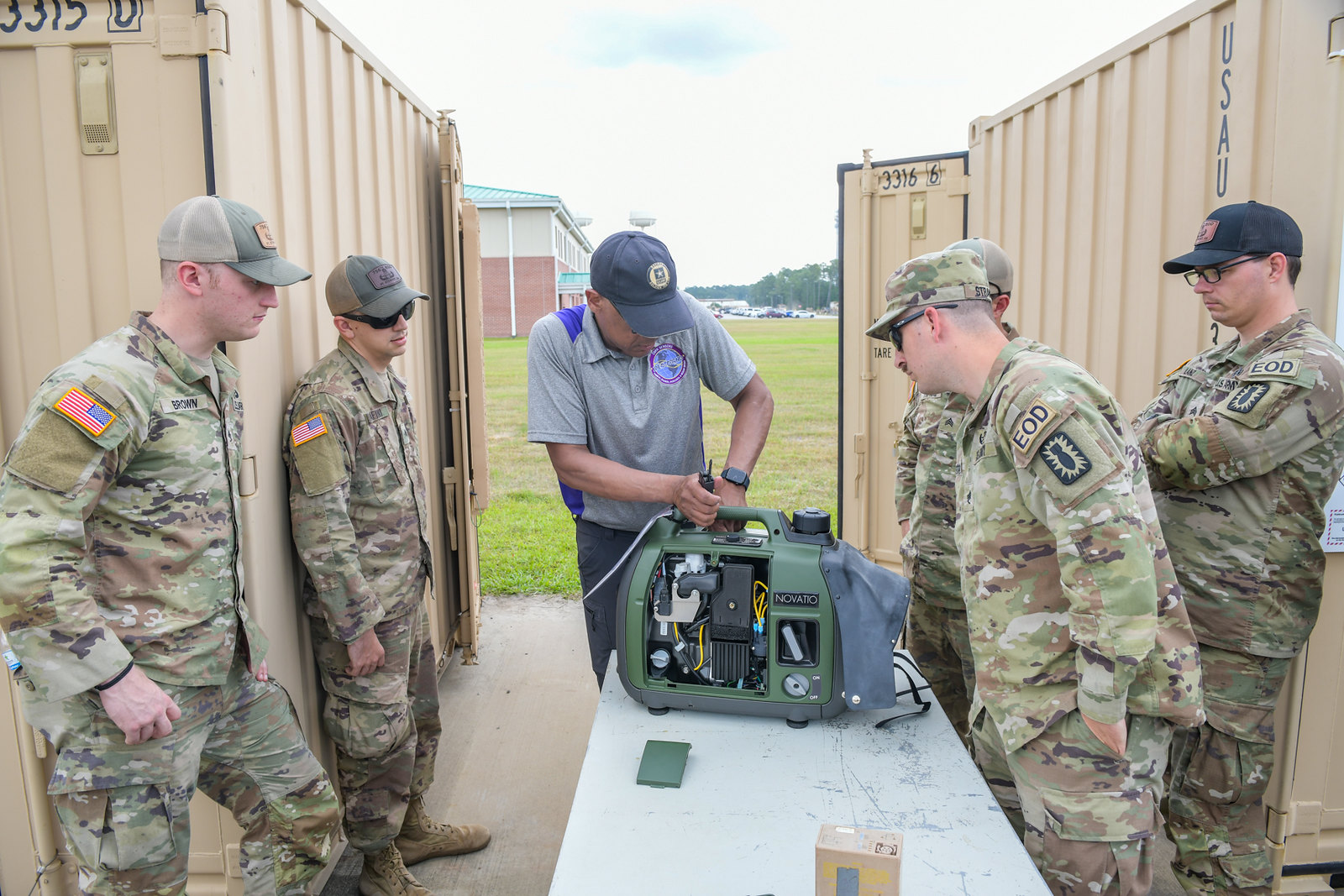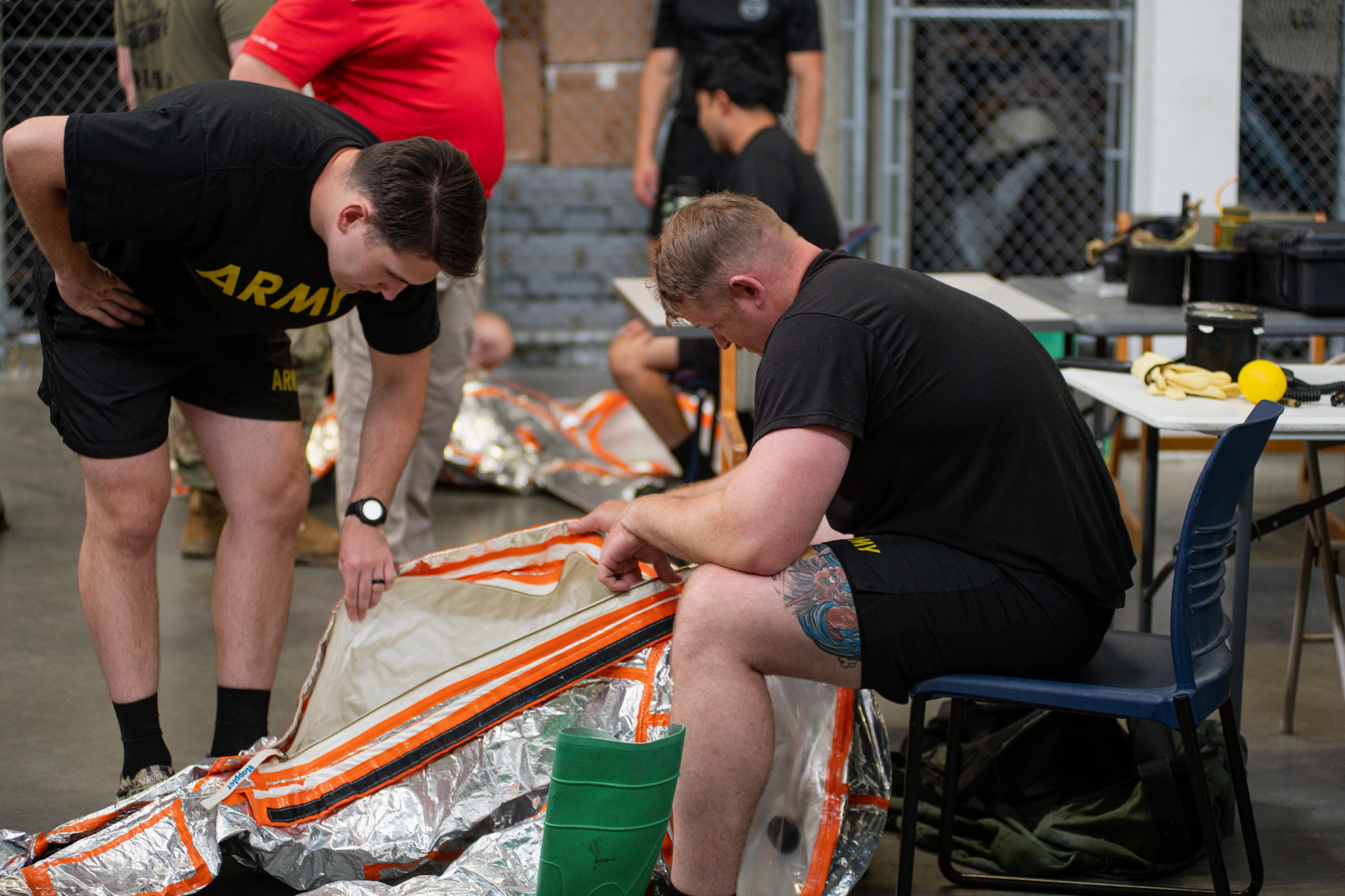The modern battlespace is dynamic. As conflicts in Ukraine and Israel unfold and perpetual threats from our adversaries loom, we continue to see implications for Chemical, Biological, Radiological and Nuclear (CBRN) defense and detection. As a Nation, we have an ongoing need to develop modernized and readily available capabilities for these CBRN threats to keep our warfighters, citizens, and global allies safe.
Cue the recent fielding of the Explosive Ordinance Disposal (EOD) variant of the Chemical, Biological, Radiological, Nuclear Dismounted Reconnaissance System (CBRN DRS). Developed by the Joint Program Executive Office for Chemical, Biological, Radiological and Nuclear Defense’s (JPEO-CBRND) Joint Project Manager for CBRN Sensors. This fielding brings the program closer to Full Operational Capability (FOC), allowing our warfighters to use this capability to enhance situational awareness and better protect themselves in CBRN contested environments.
 Above is a representation of a subterranean training simulation using the Dismounted Reconnaissance Sets, Kits and Outfits (DRSKO); part of the CBRN DRS program to provide CBRN warfighters with a comprehensive suite of protection, detection, identification, sample collection, hazard marking, decon., and other support capabilities to support safe operations.
Above is a representation of a subterranean training simulation using the Dismounted Reconnaissance Sets, Kits and Outfits (DRSKO); part of the CBRN DRS program to provide CBRN warfighters with a comprehensive suite of protection, detection, identification, sample collection, hazard marking, decon., and other support capabilities to support safe operations.
The CBRN DRS is designed to support operational and medical decision making by characterizing, through detection, identification and quantification of chemical hazards on surfaces, in liquids, and in the air. The CBRN DRS product consists of commercial off-the-shelf (COTS) and established government equipment providing detection, decontamination, and protective equipment for CBRN reconnaissance, surveillance, and assessment of sites that are inaccessible by mounted reconnaissance platforms. The EOD variant is one of 11 variants comprising the CBRN DRS product line. System Modernization Package (SMP) will be delivered to each of the services as well. SMPs provide improved time available to conduct reconnaissance and assessment missions, enhanced battlespace awareness, and increased confidence in CBRN detection and identification. The JPEO-CBRND oversees the advanced development and acquisition of the CBRN DRS and ensures protection and careful coordination with each of the services who employ this CBRN sensors capability. When asked about the value of the JPEO's fielding and CBRN DRS product, soldiers shared that "the training allowed us to improve upon our CBRN detection and mitigation which is a key component to the EOD mission."
As with the inception of any new system, the JPM CBRN Sensors team overcame many challenges and false starts to accommodate the individual needs of each service for the kit’s requirements. Over 700 kits have been fielded since the first Capability Development Document (CDD) outlined the CBRN DRS system’s requirements in 2008. The use of COTS equipment within the kits informed the need to plan for ever-changing technology updates and manage the inevitable obsolescence of its elements. Edward Conley, program officer and team lead for CBRND DRS said, “We made sure the sub-systems and components were completely dismountable for transportability and to ensure key components could be changed out. We sought world class items we knew would stay relevant and perform regression testing on changes to ensure continued readiness and relevance. Our efforts improved costs, but more importantly, helped to keep the kits in the field with the best technology available for the mission.”
Each kit contains equipment a team of warfighters need to go down range safely and conduct a site analysis for CBRN threats, including personal protective equipment (PPE), detection and identification devices, marking tags and decontamination capabilities after working in a CBRN contested environment.
 Soldiers of the 756th Ordinance Company participate in the new equipment training at Fort Stewart, GA. Above, they prepare to don a Lion MT-94 Tactix (class two) suit. The class two suit is a form of personal protective equipment (PPE) worn by the operator at incidents involving dual use industrial chemicals, chemical warfare agents, or biological agents. The suit is used with a self-contained breathing apparatus (SCBA).
Soldiers of the 756th Ordinance Company participate in the new equipment training at Fort Stewart, GA. Above, they prepare to don a Lion MT-94 Tactix (class two) suit. The class two suit is a form of personal protective equipment (PPE) worn by the operator at incidents involving dual use industrial chemicals, chemical warfare agents, or biological agents. The suit is used with a self-contained breathing apparatus (SCBA).
When a CBRN threat is suspected, warfighters can employ the CBRN DRS system by setting up a command post and decontamination line, gear up in their PPE and appropriate breathing apparatus, and deploy equipment to detect CBRN threats. Once the site is assessed, users communicate with the command post to report the status and next steps. Contaminated items are collected and brought up the line for decontamination.
Since implementation requires specialized training, CBRN DRS training exercises focus on the skills and knowledge required to prepare for and respond to CBRN threats. This includes equipment use training, emergency response transit procedures, planning and preparing for tactical reconnaissance operations, sampling and collection procedures, mission abort procedures, and the procedures to set-up, process through, and close out a survey team decontamination site. Hands-on training is subsequently carried out in scenario-based tasks in a field environment. Providing this level of training and introduction to the CBRN DRS is key to understanding its value and benefiting from its protective capacity for the units where they are fielded.
In May, the 756th Ordinance Company, within the Third Infantry Division, trained on the CBRN DRS at Fort Stewart, Georgia. The training exercise included basic overview of the capability, use case and training for how to work with the system, how to maintain the products and how the unit can hone their skills to ensure the most protection and accuracy with the suite of tools and products within the CBRN DRS kit. When asked about the recent fielding, soldiers of the 756th OC shared that "EOD Teams play a crucial role in responding to CBRN threats; the CBRN DRS fielding and training allows us to leverage our expertise, skills, and resources to neutralize hazards and ensure the safety and security of affected areas.
 Above a JPEO-CBRND trainer shows members of the 756th the Ex-Power 2000 Generator, Part of the CBRN DRS kit. The man-portable generator is the reliable choice for mobile electric power requirements, specifically designed, built, and tested for military use.
Above a JPEO-CBRND trainer shows members of the 756th the Ex-Power 2000 Generator, Part of the CBRN DRS kit. The man-portable generator is the reliable choice for mobile electric power requirements, specifically designed, built, and tested for military use.
FOC is anticipated in the fall of 2024, when the CBRN DRS EOD systems will be completely fielded to the joint force. However, there is always more work to do even after FOC to meet the emerging requirements and ongoing modernization strategy requirements across the services. With a complex set of equipment including a large percentage of COTS equipment, the team must be vigilant and watch for obsolescence of key components and watch for ways to reduce sustainment concerns.
“The adversary never rests, always coming up with new ways to challenge our forces and forcing changes to our requirements,” said Edward Conley, CBRN DRS program officer. That’s why it’s important the team conducts periodic reviews of needs vs. as-built systems and ensures the system provides the required capability. These reviews often result in analysis of the market capabilities and additional testing to ensure all fielded kits have the most relevant and functional products and gear.
Like all acquisition efforts, the JPEO-CBRND's partnerships have been essential to the program’s success in nearing the FOC milestone. “Everything we do is in partnership with others,” said Conley. Collaboration with the Tank-Automotive & Armaments Command (TACOM) and their Total Package Fielding Team, the CBRN School at Fort Leonard Wood, Missouri, the U.S. Army Combat Capabilities Development Command (DEVCOM) Chemical Biological Center, and the services have helped the CBRN DRS team achieve this feat.
 Soldiers of the 756th are prepping to don the Kappler Frontline 500 (level A) suit. This suit is used in conjunction with an SCBA as well.
Soldiers of the 756th are prepping to don the Kappler Frontline 500 (level A) suit. This suit is used in conjunction with an SCBA as well.